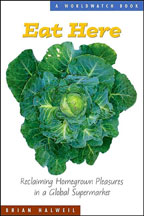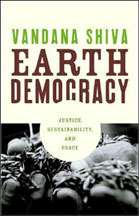 |
Have you ever walked into a supermarket in absolute
awe of the choices among the tens of thousands of items on the shelves?
What if you found
out about half of those items were produced by only 10 multinational
food and beverage companies, and the boards of these companies sum
up to roughly 140 people who dictate what’s in our kitchens?
Even vegan and organic product lines are being swallowed up by the
likes of Heinz, Kraft and General Mills. It doesn’t seem like
a whole lot of choice after all.
Have you ever wondered why apples—even shiny, organic ones—are being
imported from China when they grow right here in our backyard? What are the ethical
implications of our produce bearing the label “Made in China?”
Did you know that less than one percent of the U.S. population is engaged in
farming? There are more full-time prisoners in the U.S. than there are farmers!
And farmer suicides are on the rise worldwide with at least 16,000 in India alone
in 2004.
What is happening to our farmers and what will our future be without them?
Such questions have been occupying my mind lately and my gut reaction is a sense
of disempowerment—a feeling that we are unwillingly and unknowingly serving
empires that are not accountable to us. But Brian Halweil’s Eat Here and
Vandana Shiva’s Earth Democracy have become my recent guides, presenting
a greater understanding of the wrongs of our current food infrastructure, yet
also highlighting strategies of getting power and choice back to the people.
Eat Here by Brian Halweil (New York: W.W. Norton & Company, 2004). $13.95
paperback. 236 pages.
In Eat Here, Brian Halweil documents the drastic changes in our food infrastructure
over the last several decades. Prior to the 1950s, most food consumed in U.S.
cities was grown on nearby farms. With the application of military technology
to food production and storage, a decrease in gas prices and a subsidized interstate
highway system, long-distance shipping of food that was once impractical became
possible. Today, in grocery stores across the U.S., you may find apples from
China, even though they are grown locally. In Lima supermarkets, you’ll
find U.S. potatoes, even though Peru has more varieties of potatoes than any
other country.
Halweil explains that U.S. fruits and vegetables travel between an average of
2,500 and 4,000 kilometers from farm to market, and this long-distance hauling
of goods requires more packaging, refrigeration and fuel, resulting in huge amounts
of waste and pollution. In the U.S., food scraps and food packaging make up to
one third of total landfilled waste. The fossil fuel consumption required for
this food infrastructure will contribute to climate change and ultimately harm
farmers who are most dependent on a stable climate.
Why does this seemingly illogical system exist? Halweil further explains the “Wal-Mart
effect,” and how long-distance transport of goods and centralized distribution
better serves agribusiness producers and the leading food retailer, Wal-Mart.
The system is designed around them.
Halweil notes that while lobbyists in the U.S. advocate on behalf of our farmers
for waterway modifications along the Mississippi River to expedite and facilitate
the shipping of American soybeans, lobbyists in Brazil are advocating water infrastructure
and port projects along the Paraguay-Parana River to help Brazilian farmers send
their soybeans to the world. The lobbyists in both countries are Archer Daniels
Midland, Cargill and Bunge, who are the top soybean processors and traders along
both rivers. They are advocating these projects not to help farmers, but to pit
them against each other, ultimately, to get the cheapest price for their goods.
That is how the majority of our food system works.
The power these “food cartels” have is dangerous. Two cases in point:
Altria (the merger of Philip Morris and Nabisco) collects 10 cents of every dollar
each American consumer spends on food. The partnership of Monsanto and Cargill
presents the consolidation and control of seeds, fertilizers, pesticides, farm
financing, grain collection, grain processing and more. Consolidation is happening
at every level of food production and distribution, and is ultimately disenfranchising
consumers and small farmers alike.
Brian Halweil’s solution to combat this is the same as his book’s
title—Eat Here. By eating locally and seasonally you support small farmers
whose livelihoods are dwindling, and promote ecologically sound eating habits.
Through community supported agriculture, farmers’ markets and food cooperatives,
farmers and consumers are empowered with choice and a voice, ultimately building
food democracy. Halweil packs Eat Here with positive examples, like John Ellis’ Centerville
Market in Nebraska, which serves as a model of rebuilding local food sheds in
America’s heartland. While it’s likely that not everything can be
locally produced, Halweil advocates farmer and environmental writer Wendell Berry’s
advice: “Communities should not be exporting food before local needs are
met and should not be importing foods that can be readily produced at home.”
 |
Earth Democracy by Vandana Shiva (Cambridge, MA: South End Press, 2005). $15
paperback. 205 pages.
Vandana Shiva further explores the perniciousness of corporate globalization
as well as a movement to bring power back to the people in Earth Democracy. She
begins with principles of an earth democracy that place value on the intrinsic
worth of all life, with subsequent chapters defining living economies, democracies
and cultures that contrast the destructive forces of agribusiness.
Fundamental to this notion of democracy are food, water and seed sovereignty.
Privatization and enclosure of the commons, she asserts, disenfranchises people,
denying them their rights to live. Equally important for a healthy society
to thrive is diversity. And corporate globalization of agriculture imposes
a monoculture
of McDonald’s and Monsanto.
Shiva aggressively debunks the myths of corporate agriculture, shedding light
on the broken promises of feeding the world, increasing yield and sharing knowledge.
Shiva cites that India has not had a famine since 1942, but now regions are
experiencing hunger-starvation deaths with a shocking 47 percent of children’s deaths
caused by lack of food. Several states in India are worse off because they bought
Monsanto seed in the hopes that they would increase yield, but just the opposite
happened. In the poorest state of Bihar, farmers were left with a total crop
failure. Highest rates of farmer suicide are in Andra Pradesh and Punjab, the
two states with the highest dependence on cash crops, use of Monsanto’s
seeds and highest levels of corporate agriculture. The more our food infrastructure
is designed around corporate globalization, the less we know about where our
food comes from, and all the people displaced and disposed of as a result of
it.
Shiva also debunks the notion of “cheap food.” The ecological and
cultural costs of big agribusiness, including wars, diseases and environmental
destruction, unfortunately are externalized and born only by local communities.
Shiva fears having one company control the global trade of seeds, chemical
inputs, food prices—in short, the entire food system. This will ultimately
leave farmers only with debt. Moreover, something as fundamental to survival
as saving
and sharing seeds is becoming criminalized by intellectual property laws.
In Earth Democracy, Shiva makes a strong and powerful case against the WTO, World
Bank and IMF. Essentially these institutions have called for a shift from subsistence
farming to cash crop agriculture in the global South to feed western markets.
While at the same time subsidizing exports from the North, forcing communities
in the South to be increasingly dependent on imported food. These institutions
and their policies and agreements are not democratic processes and are imposed
against the popular will of the people. Shiva goes on to assert that these policies
are a form of genocide.
“When the 16,000 Indian farmer suicides in 2004 are viewed as a result
of economic policy, this is not suicide; it is a genocide,” citing that
trade rules inflict conditions “calculated to bring about the physical
destruction” of small farmers.
How are we to survive when farmers and their seeds are becoming endangered
species, Shiva asks? She offers solutions and highlights alternative food models.
Through
the Navdanya movement, Shiva promotes seed saving and the creation of community
seed banks to preserve biodiversity. Shiva also highlights the dabbawalas,
lunchbox carriers of Mumbai who bring homemade meals to city workers, showing
a sustainable
alternative to fast food that respects laborers and provides nourishment. Women
in Kerala are fighting Coca-Cola, anti-dam activists are protesting the “vivisection” of
the Ganges, and Shiva’s own campaign against biopiracy forced the EU to
revoke W.R. Grace’s patent on neem. A movement is growing, “like
a tree, from the bottom up.”
Brian Halweil and Vandana Shiva both end with the same conclusion. We have
to understand the politics on our plates and regain local production and consumption
of our food. This is what democracy looks like.
|
|
|
| © STEALTH TECHNOLOGIES INC. |
|